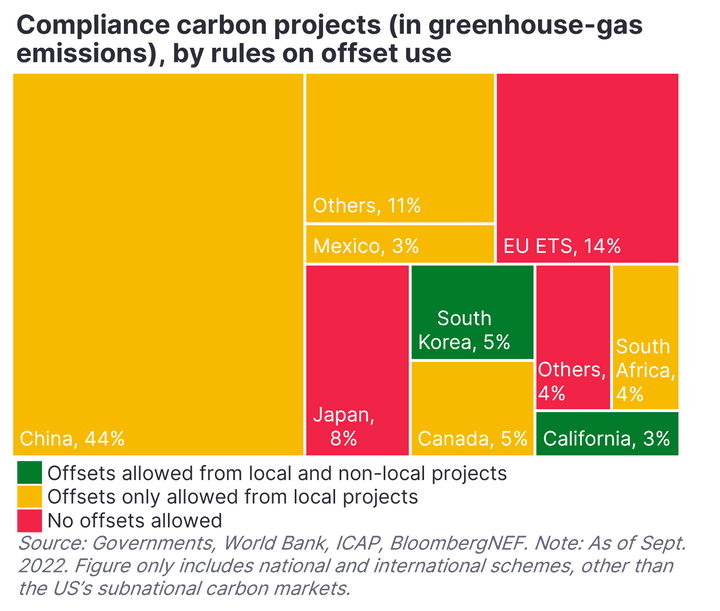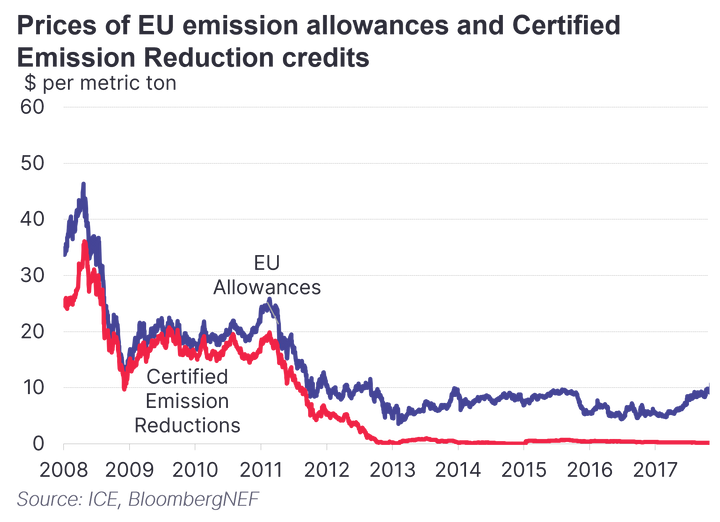Offsets in compliance carbon programsintermediate
Some of the biggest compliance carbon markets and taxes around the world allow participants to submit offsets for compliance with their emissions obligations. The aim is that emissions reduction occurs where it is cheapest to do so, while low-carbon projects can bring revenue and other benefits to local communities. In addition, offsetting can help companies in hard-to-decarbonize sectors compensate for their emissions without having to change their business models or risk investing in non-viable technologies.
Key message
Some compliance markets allow participants to use carbon offsets to meet their emission obligations. However, many governments have imposed restrictions on these credits – for example, on the location or sector of the low-carbon project – and some have banned them entirely.
#Compliance markets that allow offsets
A number of compliance markets and taxes allow participants to submit carbon offsets to meet their emissions obligation. The units are generated by low-carbon projects and typically verified via one of three mechanisms:
- National or regional carbon offset schemes linked to compliance programs, such as California’s offset scheme or Australia’s Emissions Reduction Fund
- International crediting mechanisms, such as the Clean Development Mechanism (CDM)
- Voluntary carbon registries, such as Verified Carbon Standard or Gold Standard.
Crediting mechanisms can broaden the price signal and generate low-carbon incentives in sectors not subject to compliance obligations due to technical, political or other reasons. This can spur low-carbon investment in such sectors and improves the economic efficiency of an emissions-trading scheme. These advantages, as well as lower compliance costs, could make it easier for policy makers to expand the scope of a mandatory program.
Despite these benefits, the use of offsets is more often than not subject to restrictions. One reason is ongoing concerns over the environmental integrity or quality of some offsets. For example, participants in Australia’s baseline-and-credit program and Kazakhstan’s emissions trading scheme may only use offsets from local projects, but face no volume constraints.
By contrast, several programs allow a limited proportion of compliance obligations to be met with carbon offsets – some 10% in South Korea’s emissions trading system as of June 2022, and around 75% in Canada’s Output-Based Pricing System. South Korea is one of the rare programs that allows credits generated from projects outside the jurisdiction, but the offsets may only be generated from international CDM projects developed by domestic companies.
It is also common for offset use to be subject to restrictions on the type of project and “vintage” – in other words, age. For example, emitters in Chongqing’s pilot emissions trading program may only use offsets generated from China-based projects after 2010, except for hydropower installations.
The uptake of compliance offsets could also change the dynamics in global offset markets. Since compliance schemes typically have strict criteria for eligible carbon offsets, more expensive and higher quality projects – such as robust nature-based solutions and emission-removal credits – could be drawn to compliance markets, leaving the voluntary offset market with lower-quality, lower-cost credits.

#Compliance markets that do not accept offsets
The rationale for restrictions on offset use is similar to the reasons why such credits are banned by several major compliance markets, such as the UK, European Union and New Zealand emissions trading schemes. Wariness regarding the acceptance of offsets in these programs stems from their checkered history. Until 2020, participants in the EU Emissions Trading System were allowed to submit international offsets generated under the Kyoto Protocol’s CDM and Joint Implementation (JI) for compliance. But the problems associated with their environmental integrity not only destroyed their credibility, but also led to a glut of credits, exacerbating the oversupply in the EU ETS. Certified Emission Reduction (CER) credits issued by the CDM fell from over $23 per metric ton in 2008 to just $0.01 per metric ton in 2014.

Questions around the environmental robustness of some offset projects have led to concerns about additionality, and challenges around how to quantify emission reductions. Offsetting could also delay investment in cost-effective, low-carbon solutions for hard-to-abate sectors. Furthermore, there is uncertainty around the ability of some carbon offsets to guarantee a permanent emissions reduction, while there are no such questions surrounding direct emission reductions.
Stay up to date
Sign up to be alerted when the web platform goes live.